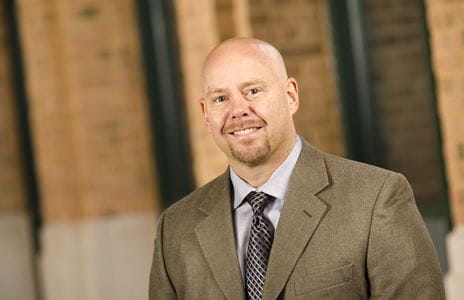Last year, as a response to the opioid crisis impacting Indiana, the Department of Psychiatry at Indiana University School of Medicine received funding through the federal 21st Century Cures Act and the Indiana Family and Social Services Agency (FSSA). Joining with IU’s Grand Challenges initiative, this grant collaborates with Prevention Insights at the IU School of Public Health-Bloomington and IUPUI’s Fairbanks School of Public Health to establish a program, the Extension for Community Healthcare Outcomes (ECHO), through which clinicians and health workers across the state can have free and easy access to accessible training in treating complex conditions related to opioid use.
Learn how the opioid use disorder program
has empowered other parts of rural Indiana.
Since moving to Columbus in 2012 and witnessing the ongoing challenges that patients face when seeking treatment for opioid use disorders, Kevin Terrell, DO, an emergency physician, knew he had to do something to improve outcomes in his own community. He also wanted to find additional opportunities for improvement in Bartholomew County and its response to the opioid epidemic.
“I wanted to be part of the solution,” Terrell said.
How has the opioid epidemic impacted Columbus?
When the epidemic hit the area in 2013, we started seeing more people overdosing on pain pills. You know it’s a crisis when you can witness one patient overdosing three times within 72 hours. Unfortunately, there were very few treatment opportunities for these patients. Over the past five years, the overdose death rate in Bartholomew County has risen dramatically. For instance, in 2015 there was only one death caused by overdose but in 2017 that number rose to 30. While the numbers are still coming in for 2018, the death rate caused by overdose does appear to be lower than last year’s. That is most likely a result of several factors, including reduced opioid prescriptions in our communities, the availability of Narcan, an opioid overdose antidote, without a prescription, and successful education.
What kind of education has helped you the most?
Last year, when I learned about the ECHO program, I saw it as a great way to learn more about medicine-assisted treatments and bring that expertise to my community. It has been a primary way I stay up-to-date on addiction medicine as a specialty, but it really helps educate me as I continue taking care of patients who have opioid use disorders. I’ve attended conferences about addiction medicine but the difference between those programs and ECHO is that I have an expert panel in Indianapolis who I can present cases in real-time and get feedback on how to treat and approach each case. You really can’t get that kind of help anywhere else; it simply doesn’t exist.
In what ways has the opioid use disorder ECHO program impacted you most?
It’s really nerve-wracking entering a new type of practice, but the ECHO program makes it possible. Sometimes there are patients or situations that I’m just not sure how to navigate. In a community like Columbus, where this access otherwise wouldn’t be possible, a program where you can present and bounce ideas and real cases with subject-matter experts is unmeasurable. This program instills comfort and confidence for primary care physicians and has been a huge help for me in knowing who to treat, how to treat and when to treat.
Talk about the new addiction treatment center.
We are opening an addiction medicine treatment program through Columbus Regional Health, called the Treatment and Support Center (TASC), and we expect it to open in July of this year. TASC will provide evidence-based treatment for patients with substance use disorders. Here we’ll provide psychosocial therapy to all patients and prescribe medication to eligible patients who have opioid use disorders and/ or alcohol use disorders. Without the education that I’ve had, and continue to have, through the opioid use disorder ECHO program, I wouldn’t be ready to provide care and lead an addiction practice like this. ECHO has been an essential ingredient in my development as a physician who provides addiction care, and the Treatment and Support Center is a real tangible outcome of that.
What other ways has the Columbus-area addressed the opioid epidemic?
In addition to the treatment and support center, we launched the Alliance for Substance Abuse Progress (ASAP) program in 2017 where I serve as a physician lead. ASAP was founded as our community’s response to the opioid epidemic and is a partnership with Columbus Regional Hospital, the city of Columbus and Bartholomew County. The program’s four main areas of focus are prevention, intervention (largely through the county’s judicial system), treatment (which will take place at the soon-opening Treatment and Support Center) and recovery. I share much of what I have learned through the ECHO program with my colleagues and members of our community during our regular report out sessions.
In just seven years it seems clear that not only has Terrell become part of the solution in reducing the death rate in the Columbus area, but he’s also planting what he’s learned from the opioid use disorder ECHO program in the minds of his colleagues and patients throughout all of Bartholomew County.
Learn more about the opioid use disorder ECHO program and IU School of Medicine’s response to the opioid epidemic.
